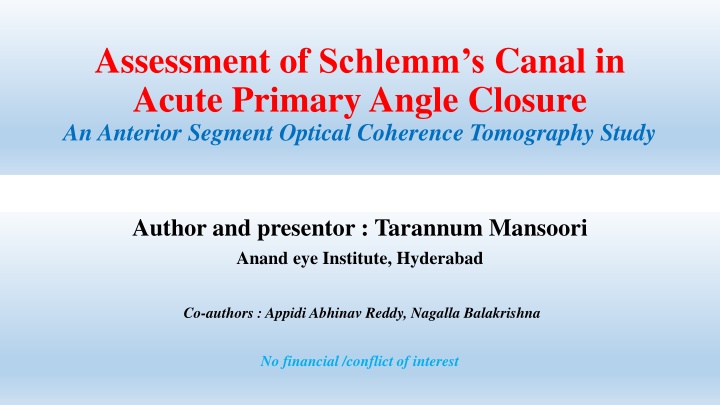Assessment of Schlemm's Canal in Acute Primary Angle Closure: AS-OCT Study
Study conducted by Tarannum Mansoori and team aimed to evaluate Schlemm's canal (SC) dimensions in acute primary angle closure (APAC) using anterior segment optical coherence tomography (AS-OCT). Their findings indicate changes in SC parameters post-treatment, emphasizing the importance of SC in maintaining normal intraocular pressure. Statistical analysis showed significant differences in SC measurements between normal controls, APAC patients, and post-treatment APAC cases.
Download Presentation

Please find below an Image/Link to download the presentation.
The content on the website is provided AS IS for your information and personal use only. It may not be sold, licensed, or shared on other websites without obtaining consent from the author.If you encounter any issues during the download, it is possible that the publisher has removed the file from their server.
You are allowed to download the files provided on this website for personal or commercial use, subject to the condition that they are used lawfully. All files are the property of their respective owners.
The content on the website is provided AS IS for your information and personal use only. It may not be sold, licensed, or shared on other websites without obtaining consent from the author.
E N D
Presentation Transcript
Assessment of Schlemms Canal in Acute Primary Angle Closure An Anterior Segment Optical Coherence Tomography Study Author and presentor : Tarannum Mansoori Anand eye Institute, Hyderabad Co-authors : Appidi Abhinav Reddy, Nagalla Balakrishna No financial /conflict of interest
INTRODUCTION Schlemm s canal (SC) plays a role in the aqueous humour outflow through the trabeculo-canalicular pathway and maintenance of normal intraocular pressure (IOP) Previous studies using anterior segment optical coherence tomography (AS-OCT) 1-2 Raised IOP Collapse of SC Reduction in SC size PURPOSE To image and evaluate Schlemm s canal (SC) dimensions in the eyes with acute primary angle closure (APAC) at presentation, using AS-OCT (Optovue, Inc, Fremont, CA, USA) and compare SC measurements 1 week after IOP control and peripheral iridotomy and compare with normal age-matched controls 1. Kagemann L, Wang B, Wollstein G, Ishikawa H, Nevins JE, Nadler Z et al (2014) IOP elevation reduces Schlemm s canal cross-sectional area. Invest Ophthalmol Vis Sci 55:1805 1809 2. Allingham RR, de Kater AW, Ethier CR (1996) Schlemm s canal and primary open angle glaucoma: correlation between Schlemm s canal dimensions and outflow facility. Exp Eye Res 62:101 109
Materials and Methods Prospective comparative study August 2017 to February 2019 All the participants gave informed consent for the study Participants 17 eyes of 14 newly diagnosed APAC patients & 59 age-matched normal subjects Eyes were scanned with AS-OCT using corneal line scan (8 mm scan length), placed at limbus in the nasal and temporal horizontal meridian (3 and 9 o clock position), repeated thrice Exclusion criteria Images with poor resolution, motion artefact, excessive noise or shadowing Based on the image quality, only one image was chosen for the final analysis
AS-OCT were exported using OCT files and were opened using Image J 2 tool SC cross sectional area (CSA) : Fitting optimal ellipse to the SC SC meridional diameter : measured anterior to posterior end point of SC SC coronal diameter : Maximum distance between the inner and outer wall of SC-CSA Table : Comparison of Schlemm's canal parameters of normal, APAC and post treatment APAC patients after one week Paramet ers Normal control a Acute primary angle closure (APAC) b APAC after laser iridotom y and IOP control (after 3 weeks) c 6499 + 0.67 P value (a and b) P value (b and c ) P value (a and c) 7192 + 102 10600 + 269 0.025 Mean SC area ( m 2 ) < 0.0001 0.85 499.2 + 179.8 681.9 + 124.8 499.8 + 169.3 < 0.0001 Mean SC diameter Horizona tal ( m) Mean SC diameter Vertical ( m) < 0.0001 0.99 Statistical analysis : SPSS software version 16 (SPSS Inc., Chicago, IL, USA) 15.43 + 4.35 21.22 + 8.19 15.75 + 0.011 Levene s test was used for the equality of variances Comparison between the groups : Independent sample student t test 0.015 0.86 8.6
Discussion We speculate that the increased SC area and diameters could be due to its response to a sudden rise in IOP, where it compensates by distension Significant expansion of SC in APAC eyes during acute attack Reduction in SC size after IOP control, comparable to normal eyes As compared to its response in the chronic rise in IOP, where the SC has been reported to be compressed and reduced in dimensions After the acute attack is resolved, the SC dimensions comparatively reduced in the size, which could possibly mean that SC regains its original area and size after IOP reduction A B Figure : AS-OCT images of the Schlemm s canal (white arrow) in an eye with APAC, at presentation (A) and at a week after the resolution of acute attack (B)
Conclusions Pathological effect of sudden IOP elevation on SC has not been reported in the APAC SC shows significant expansion during an acute attack of APAC AS-OCT is a good tool to assessing these changes and monitoring treatment outcomes Further studies with larger sample size are needed to validate the alteration in the SC in response to a sudden increase in the IOP























